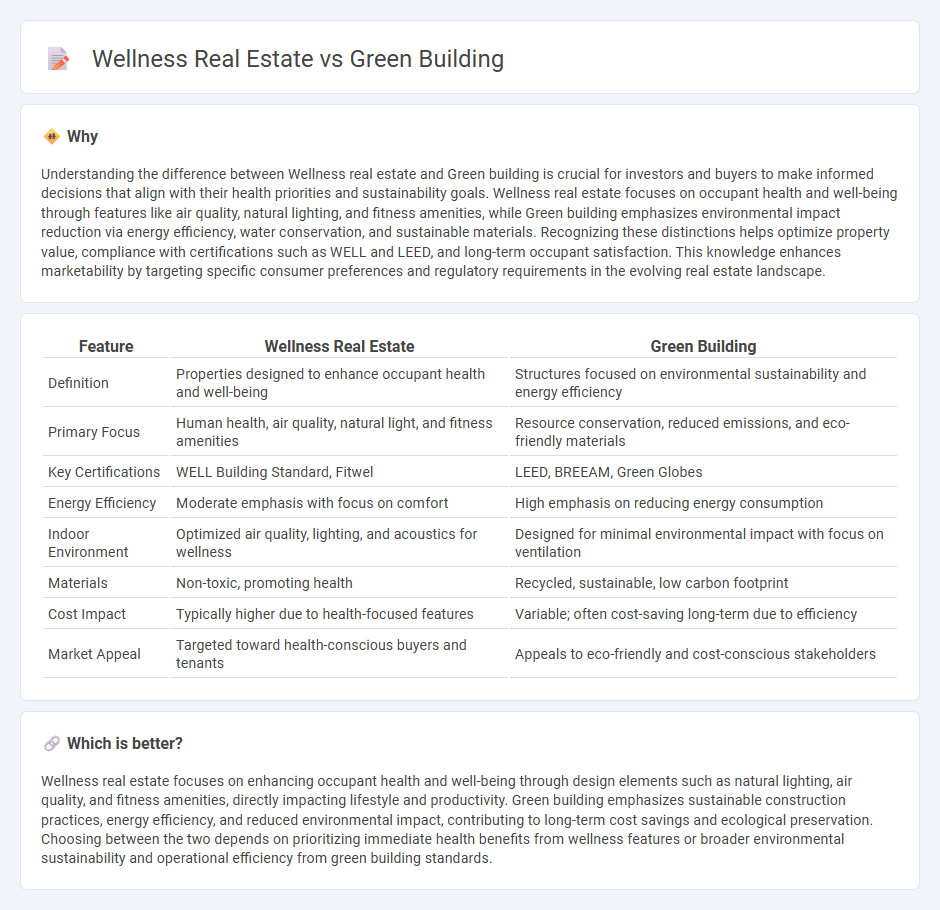
Wellness real estate focuses on creating living spaces that enhance occupants' health and well-being through features like improved air quality, natural lighting, and fitness amenities. Green building emphasizes sustainable construction practices that reduce environmental impact by utilizing energy-efficient materials and renewable resources. Explore the key differences and benefits of wellness real estate versus green building to make informed property decisions.
Why it is important
Understanding the difference between Wellness real estate and Green building is crucial for investors and buyers to make informed decisions that align with their health priorities and sustainability goals. Wellness real estate focuses on occupant health and well-being through features like air quality, natural lighting, and fitness amenities, while Green building emphasizes environmental impact reduction via energy efficiency, water conservation, and sustainable materials. Recognizing these distinctions helps optimize property value, compliance with certifications such as WELL and LEED, and long-term occupant satisfaction. This knowledge enhances marketability by targeting specific consumer preferences and regulatory requirements in the evolving real estate landscape.
Comparison Table
| Feature | Wellness Real Estate | Green Building |
|---|---|---|
| Definition | Properties designed to enhance occupant health and well-being | Structures focused on environmental sustainability and energy efficiency |
| Primary Focus | Human health, air quality, natural light, and fitness amenities | Resource conservation, reduced emissions, and eco-friendly materials |
| Key Certifications | WELL Building Standard, Fitwel | LEED, BREEAM, Green Globes |
| Energy Efficiency | Moderate emphasis with focus on comfort | High emphasis on reducing energy consumption |
| Indoor Environment | Optimized air quality, lighting, and acoustics for wellness | Designed for minimal environmental impact with focus on ventilation |
| Materials | Non-toxic, promoting health | Recycled, sustainable, low carbon footprint |
| Cost Impact | Typically higher due to health-focused features | Variable; often cost-saving long-term due to efficiency |
| Market Appeal | Targeted toward health-conscious buyers and tenants | Appeals to eco-friendly and cost-conscious stakeholders |
Which is better?
Wellness real estate focuses on enhancing occupant health and well-being through design elements such as natural lighting, air quality, and fitness amenities, directly impacting lifestyle and productivity. Green building emphasizes sustainable construction practices, energy efficiency, and reduced environmental impact, contributing to long-term cost savings and ecological preservation. Choosing between the two depends on prioritizing immediate health benefits from wellness features or broader environmental sustainability and operational efficiency from green building standards.
Connection
Wellness real estate integrates health-focused design elements such as natural lighting, improved air quality, and biophilic features that align closely with green building principles emphasizing sustainability and energy efficiency. Both sectors prioritize the use of eco-friendly materials and technologies to minimize environmental impact while enhancing occupant well-being. This synergy supports healthier lifestyles and sustainable living environments, driving demand in modern real estate development.
Key Terms
Sustainable Materials
Sustainable materials in green building prioritize eco-friendly, low-impact resources like recycled steel, bamboo, and low-VOC paints to minimize environmental footprint and energy consumption. Wellness real estate integrates sustainable materials with health-focused elements, such as non-toxic finishes and natural ventilation, to enhance indoor air quality and occupant well-being. Explore how sustainable materials shape the future of eco-conscious and health-centric property development.
Indoor Air Quality
Green building emphasizes sustainable construction techniques and materials that reduce environmental impact, often incorporating advanced ventilation systems to enhance indoor air quality. Wellness real estate prioritizes occupant health and comfort by integrating features like air purifiers, humidity control, and pollutant monitoring to improve the living environment. Explore the differences between green building and wellness real estate approaches to indoor air quality for healthier, more sustainable living spaces.
Biophilic Design
Biophilic design integrates natural elements into built environments, enhancing both green buildings and wellness real estate by promoting occupant health, productivity, and environmental sustainability. Green buildings emphasize energy efficiency, reduced carbon footprint, and sustainable materials, while wellness real estate prioritizes indoor environmental quality, natural light, and access to nature for improved mental and physical well-being. Explore how biophilic design bridges these sectors to create spaces that support ecological balance and human health.
Source and External Links
Green building - Wikipedia - Green building is an environmentally responsible and resource-efficient construction approach applied throughout a building's entire life cycle to reduce pollution, save resources, and create healthy, comfortable spaces in harmony with nature.
What Is Green Building? - IBM - Green building focuses on reducing carbon footprint through energy-efficient design, renewable energy use, smart technologies, effective ventilation, water conservation, and promoting occupant well-being.
Green Buildings | PNNL - Green buildings minimize negative environmental impacts by using less water, energy, renewable resources, eco-friendly materials, and aim to create healthy environments with net-positive effects such as generating their own energy.
 dowidth.com
dowidth.com